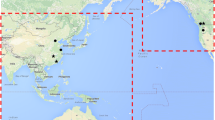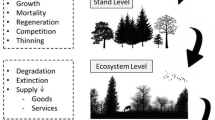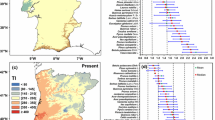Abstract
The impacts of climate change traverse administrative borders, which calls for new strategies for forest ecosystem conservation and adaptive management. Despite relatively high biodiversity, the temperate forests in East Asia have lacked a comprehensive regional evaluation of potential climate change impacts. Here, we assess the level of climate change exposure of the Temperate Broadleaf and Mixed Forests Biome of East Asia by 2070. These temperate forests occupy 18 ecoregions, five countries, and 102 provinces. We categorize climate change exposure by classifying baseline (1960–1990) climate conditions for the current geographic distribution of five temperate forest types within each ecoregion and within the biome. We then measure the level of change under four future climates: a warmer or a hotter future climate and under reduced emissions (RCP4.5) or with emissions continuing unabated (RCP8.5). By 2070, using the RCP8.5 emission scenario, 24.5–65.7% of these forests enter non-analog or the most marginal 1% of baseline climate conditions. These results reveal the need for extensive transboundary governmental coordination, including forest preservation actions among 51 of 54 provinces that will retain some forest locations in climatically stable or low-risk conditions. Furthermore, among 96 provinces with forests that will be highly exposed, 90 will require transboundary climate change adaptation strategies because these forests span their borders, including the border areas of China, the Russian Federation, and North Korea. The analytical approach of this study could serve as a template for supporting transboundary institutional coordination to address climate change.





Similar content being viewed by others
References
Abatzoglou JT, Williams AP (2016) Impact of anthropogenic climate change on wildfire across western US forests. Proc Natl Acad Sci 113:11770–11775
Aubin I, Munson AD, Cardou F, Burton PJ, Isabel N, Pedlar JH, Paquette A, Taylor AR, Delagrange S, Kebli H, Messier C, Shipley B, Valladares F, Kattge J, Boisvert-Marsh L, McKenney D (2016) Traits to stay, traits to move: a review of functional traits to assess sensitivity and adaptive capacity of temperate and boreal trees to climate change. Environ Rev 24:164–186
Bailey RG (2014) Ecoregions: the ecosystem geography of the oceans and continents, Second edn. Springer, New York
Benzie M, Carter T, Groundstroem F, Carlsen H, Savvidou G, Pirttioja N, Taylor R, Dzebo A (2017) Implications for the EU of cross-border climate change impacts. EU FP7 IMPRESSIONS Project Deliverable D3A.2
Bonan GB (2008) Forests and climate change: Forcings, feedbacks, and the climate benefits of forests. Science 320:1444–1449
Bower AD, St. Clair JB, Erickson V (2014) Generalized provisional seed zones for native plants. Ecol Appl 24:913–919
Braack L, Sandwith T, Peddle D, Petermann T (2006) Security considerations in the planning and management of transboundary conservation areas. IUCN, Gland, Switzerland and Cambridge, UK
Broxton PD, Zeng X, Sulla-Menashe D, Troch PA (2014) A global land cover climatology using MODIS data. J Appl Meteorol Climatol 53:1593–1605
Chapin FS, Matson PA, Vitousek P (2011) Principles of terrestrial ecosystem ecology. Springer, New York
Choe H, Thorne JH (2017) Integrating climate change and land use impacts to explore forest conservation policy. Forests 8:321
Choe H, Thorne JH, Seo C (2016) Mapping national plant biodiversity patterns in South Korea with the MARS species distribution model. PLoS One 11:e0149511
Choe H, Thorne JH, Hijmans R, Kim J, Kwon H, Seo C (2017a) Meta-corridor solutions for climate-vulnerable plant species groups in South Korea. J Appl Ecol 54:1742–1754
Choe H, Thorne JH, Lee D (2017b) Comparing climate projections for Asia, East Asia and South Korea. Journal of Environmental Impact Assessment 26:114–126
Choe H, Thorne JH, Huber PR, Lee D, Quinn JF (2018) Assessing shortfalls and complementary conservation areas for national plant biodiversity in South Korea. PLoS One 13:e0190754
Choe H, Thorne JH, Hijmans R, Seo C (2019) Integrating the Rabinowitz rarity framework with a national plant inventory in South Korea. Ecology and Evolution 9:1353–1363
Chuine I, Beaubien EG (2001) Phenology is a major determinant of tree species range. Ecol Lett 4:500–510
Elith J, Leathwick JR (2009) Species distribution models: ecological explanation and prediction across space and time. Annu Rev Ecol Evol Syst 40:677–697
Ellison D, Morris CE, Locatelli B, Sheil D, Cohen J, Murdiyarso D, Gutierrez V, Mv N, Creed IF, Pokorny J, Gaveau D, Spracklen DV, Tobella AB, Ilstedt U, Teuling AJ, Gebrehiwot SG, Sands DC, Muys B, Verbist B, Springgay E, Sugandi Y, Sullivan CA (2017) Trees, forests and water: cool insights for a hot world. Glob Environ Chang 43:51–61
Enquist CAF, Jackson ST, Garfin GM, Davis FW, Gerber LR, Littell JA, Tank JL, Terando AJ, Wall TU, Halpern B, Hiers JK, Morelli TL, McNie E, Stephenson NL, Williamson MA, Woodhouse CA, Yung L, Brunson MW, Hall KR, Hallett LM, Lawson DM, Moritz MA, Nydick K, Pairis A, Ray AJ, Regan C, Safford HD, Schwartz MW, Shaw MR (2017) Foundations of translational ecology. Front Ecol Environ 15:541–550
ESRI (2015) ArcGIS release 10.3.1. Redlands, CA.
Favero A, Mendelsohn R, Sohngen B (2017) Using forests for climate mitigation: sequester carbon or produce woody biomass? Clim Chang 144:195–206
Fitzpatrick MC, Blois JL, Williams JW, Nieto-Lugilde D, Maguire KC, Lorenz DJ (2017) How will climate novelty influence ecological forecasts? Using the Quaternary to assess future reliability. Glob Chang Biol 24:3575–3586
Gavin DG, Fitzpatrick MC, Gugger PF, Heath KD, Rodríguez-Sánchez F, Dobrowski SZ, Hampe A, Hu FS, Ashcroft MB, Bartlein PJ, Blois JL, Carstens BC, Davis EB, Lafontaine G, Edwards ME, Fernandez M, Henne PD, Herring EM, Holden ZA, Kong W, Liu J, Magri D, Matzke NJ, McGlone MS, Saltré F, Stigall AL, Tsai YE, Williams JW (2014) Climate refugia: joint inference from fossil records, species distribution models and phylogeography. New Phytol 204:37–54
Gonzalez P, Neilson RP, Lenihan JM, Drapek RJ (2010) Global patterns in the vulnerability of ecosystems to vegetation shifts due to climate change. Glob Ecol Biogeogr 19:755–768
Hannah L (2010) A global conservation system for climate-change adaptation. Conserv Biol 24:70–77
Hänninen H (1995) Effects of climatic change on trees from cool and temperate regions: an ecophysiological approach to modelling of bud burst phenology. Can J Bot 73:183–199
Higuchi H, Primack RB (2009) Conservation and management of biodiversity in Japan: an introduction. Biol Conserv 142:1881–1883
Hijmans RJ, Cameron SE, Parra JL, Jones PG, Jarvis A (2005) Very high resolution interpolated climate surfaces for global land areas. Int J Climatol 25:1965–1978
Hoffmann AA, Sgro CM (2011) Climate change and evolutionary adaptation. Nature 470:479–485
Keenan RJ (2015) Climate change impacts and adaptation in forest management: a review. Ann For Sci 72:145–167
Kim KC (1997) Preserving biodiversity in Korea’s demilitarized zone. Science 278:242–243
Kucharik CJ, Barford CC, Maayar ME, Wofsy SC, Monson RK, Baldocchi DD (2006) A multiyear evaluation of a dynamic global vegetation model at three Ameriflux forest sites: vegetation structure, phenology, soil temperature, and CO2 and H2O vapor exchange. Ecol Model 196:1–31
Lee D (2015) Korean climate change assessment report 2014. South Korea Ministry of Environment and National Institute of Environmental Research. (In Korean)
Lenoir J, Svenning JC (2015) Climate-related range shifts—a global multidimensional synthesis and new research directions. Ecography 38:15–28
Li T, Shilling F, Thorne J, Li F, Schott H, Boynton R, Berry AM (2010) Fragmentation of China’s landscape by roads and urban areas. Landsc Ecol 25:839–853
Liu J, Diamond J (2008) Revolutionizing China’s environmental protection. Science 319:37–38
Loarie SR, Duffy PB, Hamilton H, Asner GP, Field CB, Ackerly DD (2009) The velocity of climate change. Nature 462:1052–1055
McDowell G, Ford J, Jones J (2016) Community-level climate change vulnerability research: trends, progress, and future directions. Environ Res Lett 11:033001
McNeely JA, Kapoor-Vijay P, Zhi LU, Olsvig-Whittaker L, Sheikh KM, Smith AT (2009) Conservation biology in Asia: the major policy challenges. Conserv Biol 23:805–810
Millar CI, Stephenson NL (2015) Temperate forest health in an era of emerging megadisturbance. Science 349:823–826
Millar CI, Stephenson NL, Stephens SL (2007) Climate change and forests of the future: managing in the face of uncertainty. Ecol Appl 17:2145–2151
Miyawaki A (1984) A vegetation-ecological view of the Japanese archipelago. Bull Inst Environ Sci Technol 11:85–101
Mongolian National Commission for UNESCO (2015) Report of the 13th Meeting of UNESCO MAB East Asian Biosphere Reserve Network (EABRN)
Morelli TL, Daly C, Dobrowski SZ, Dulen DM, Ebersole JL, Jackson ST, Lundquist JD, Millar CI, Maher SP, Monahan WB, Nydick KR, Redmond KT, Sawyer SC, Stock S, Beissinger SR (2016) Managing climate change refugia for climate adaptation. PLoS One 11:e0159909
Morita K, Ki M (2018) Synergies among climate change and biodiversity conservation measures and policies in the forest sector: a case study of southeast Asian countries. Forest Policy Econ 87:59–69
Nymark A (2002) Canada-U.S. environmental cooperation. Canada-United States Law Journal 28:27–36
Olson DM, Dinerstein E, Wikramanayake ED, Burgess ND, Powell GVN, Underwood EC, D'amico JA, Itoua I, Strand HE, Morrison JC, Loucks CJ, Allnutt TF, Ricketts TH, Kura Y, Lamoreux JF, Wettengel WW, Hedao P, Kassem KR (2001) Terrestrial ecoregions of the world: a new map of life on earth: a new global map of terrestrial ecoregions provides an innovative tool for conserving biodiversity. BioScience 51:933–938
Park C, Min SK, Lee D, Cha DH, Suh MS, Kang HS, Hong SY, Lee DK, Baek HJ, Boo KO, Kwon WT (2016) Evaluation of multiple regional climate models for summer climate extremes over East Asia. Clim Dyn 46:2469–2486
Payn T, Carnus J-M, Freer-Smith P, Kimberley M, Kollert W, Liu S, Orazio C, Rodriguez L, Silva LN, Wingfield MJ (2015) Changes in planted forests and future global implications. For Ecol Manag 352:57–67
Sandwith T, Besancon C (2005) Trade-offs among multiple goals for transboundary conservation. Draft paper presented at environmental change and security program symposium: parks for peace or peace for parks? Issues in practice and policy. Woodrow Wilson International Center for Scholars, Washington DC, USA
Scherrer D, Massy S, Meier S, Vittoz P, Guisan A (2017) Assessing and predicting shifts in mountain forest composition across 25 years of climate change. Divers Distrib 23:517–528
Tang Z, Wang Z, Zheng C, Fang J (2006) Biodiversity in China’s mountains. Front Ecol Environ 4:347–352
Tang L, Shao G, Piao Z, Dai L, Jenkins MA, Wang S, Wu G, Wu J, Zhao J (2010) Forest degradation deepens around and within protected areas in East Asia. Biol Conserv 143:1295–1298
The Government of Japan (2013) Japan’s sixth national communication under the United Nations Framework Convention on Climate Change
Thom D, Rammer W, Dirnböck T, Müller J, Kobler J, Katzensteiner K, Helm N, Seidl R (2017) The impacts of climate change and disturbance on spatio-temporal trajectories of biodiversity in a temperate forest landscape. J Appl Ecol 54:28–38
Thorne JH, Boynton RM, Holguin AJ, Stewart JAE, Bjorkman J (2016) A climate change vulnerability assessment for California’s vegetation: a macro-habitat scale for aggregated terrestrial vegetation types. California Department of Wildlife and Fisheries, Sacramento, CA
Thorne JH, Choe H, Boynton RM, Bjorkman J, Albright W, Nydick K, Flint AL, Flint LE, Schwartz MW (2017) The impact of climate change uncertainty on California’s vegetation and adaptation management. Ecosphere 8:e02021
Thorne JH, Choe H, Stine PA, Chambers JC, Holguin A, Kerr AC, Schwartz MW (2018) Climate change vulnerability assessment of forests in the Southwest USA. Clim Chang 148:387–402
van der Linde H, Oglethorpe J, Sandwith T, Snelson D, Tessema Y (2001) Beyond boundaries: transboundary natural resource management in Sub-Saharan Africa. Washington, D.C., U.S.A.: Biodiversity Support Program
Wall TU, McNie E, Garfin GM (2017) Use-inspired science: making science usable by and useful to decision makers. Front Ecol Environ 15:551–559
Walther GR, Post E, Convey P, Menzel A, Parmesan C, Beebee TJC, Fromentin J-M, Hoegh-Guldberg O, Bairlein F (2002) Ecological responses to recent climate change. Nature 416:389–395
Williams JW, Jackson ST (2007) Novel climates, no-analog communities, and ecological surprises. Front Ecol Environ 5:475–482
Williams JN, Rivera R, Choe H, Schwartz MW, Thorne JH (2018) Climate risk on two vegetation axes—tropical wet-to-dry and temperate arid-to-moist forests. J Biogeogr 45:2361–2374
Yin Y, Ma D, Wu S (2018) Climate change risk to forests in China associated with warming. Sci Rep 8:493
Acknowledgements
We appreciate the global data depositories for public use including the World Wildlife Fund, USGS Land Cover Institute, WorldClim, and Natural Earth. We thank Professor James F. Quinn for providing lab and computing facilities and Professor Mark W. Schwartz for comments on the manuscript. This work was supported by the National Research Foundation of Korea (NRF) grant funded by the Korean government (MSIT) (No. 2019R1G1A1005770).
Author information
Authors and Affiliations
Corresponding author
Additional information
Publisher’s note
Springer Nature remains neutral with regard to jurisdictional claims in published maps and institutional affiliations.
Rights and permissions
About this article
Cite this article
Choe, H., Thorne, J.H. Climate exposure of East Asian temperate forests suggests transboundary climate adaptation strategies are needed. Climatic Change 156, 51–67 (2019). https://doi.org/10.1007/s10584-019-02493-8
Received:
Accepted:
Published:
Issue Date:
DOI: https://doi.org/10.1007/s10584-019-02493-8




